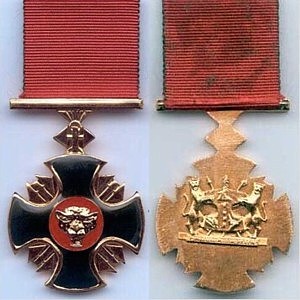
The Louw Wepener Decoration, post-nominal letters LWD, is a military decoration for bravery which was instituted by the Union of South Africa in 1952. It was awarded to members of the South African Defence Force for acts of the most conspicuous courage or greatest heroism. The decoration was discontinued on 1 July 1975, when a new set of decorations and medals was instituted.

The Star of South Africa, post-nominal letters SSA, is a military decoration for merit which was instituted by the Union of South Africa from 1952 to 1975. It was awarded to general and flag officers of the South African Defence Force for exceptionally meritorious service. The Star of South Africa was discontinued on 1 July 1975, when a new set of orders, decorations and medals was instituted.

The Van Riebeeck Medal, post-nominal letters VRM, is a military decoration for bravery which was instituted by the Union of South Africa in 1952. It was awarded to other ranks for distinguished service in the field.

The Louw Wepener Medal, post-nominal letters LWM, is a South African military decoration for bravery which was instituted by the Republic of South Africa on 20 October 1967. It was awarded to members of the South African Defence Force for courageous or heroic deeds in saving lives. The Louw Wepener Medal was discontinued on 1 July 1975, when a new set of decorations and medals was instituted.

The Independence Medal was instituted by the State President of the Republic of Bophuthatswana to commemorate that country's independence on 6 December 1977. It was awarded to all ranks on the active strength of the Bophuthatswana Defence Force upon independence.

The Medal for Long Service and Good Conduct, Gold was instituted by the State President of the Republic of Bophuthatswana in 1982, for award to all ranks as a long service medal for thirty years service and good conduct.

The General Service Medal was instituted by the State President of the Republic of Bophuthatswana in 1991, for award to all ranks for operational service inside Bophuthatswana.

The Nkwe Medal was instituted by the State President of the Republic of Bophuthatswana in 1990, for award to all ranks for operational service.

The Marumo Medal, Class I was instituted by the State President of the Republic of Bophuthatswana in 1988.

The Marumo Medal, Class II was instituted by the State President of the Republic of Bophuthatswana in 1988.

The Defence Force Commendation Medal was instituted by the State President of the Republic of Bophuthatswana in 1982. It could be awarded to all ranks for service of a high standard.

The Defence Force Merit Medal was instituted by the State President of the Republic of Bophuthatswana in 1982, for award to all ranks for extraordinarily excellent service and particular devotion to duty.

The Defence Force Merit Decoration was instituted by the State President of the Republic of Bophuthatswana in 1982, for award to officers for distinguished service of high quality and utmost devotion to duty.

The Distinguished Gallantry Medal was instituted by the State President of the Republic of Bophuthatswana in 1982, for award to all ranks for extraordinary gallantry.

The Gallantry Cross, Gold was instituted by the President of the Republic of Venda in 1985, for award to all ranks for extreme courage or supreme bravery or valour beyond the normal call of duty.

The Gallantry Cross, Silver, post-nominal letters GCS, was instituted by the President of the Republic of Venda in 1985, for award to all ranks for courage or bravery or valour beyond the normal call of duty.

The Distinguished Service Medal, Gold was instituted by the President of the Republic of Venda in 1985, for award to all ranks for exceptionally meritorious service and particular devotion to duty.

The Distinguished Service Medal, Silver was instituted by the President of the Republic of Venda in 1985, for award to all ranks for outstanding service and devotion to duty.

The Venda Defence Force Medal was instituted by the President of the Republic of Venda in 1984, for award to all ranks for service of a high standard.

The Long Service Medal, Gold was instituted by the President of the Republic of Venda in 1985, for award to all ranks for thirty years exemplary service.




















